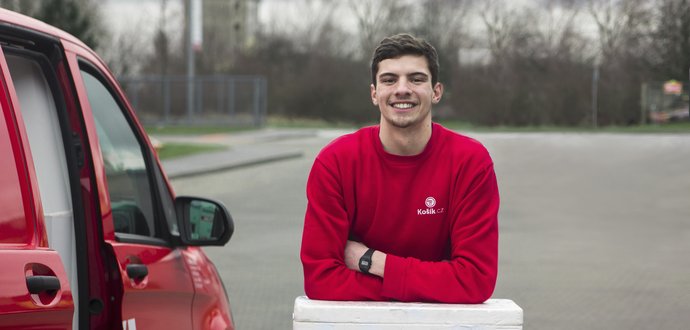Úspora času, peněz a nákladů na benzín jsou hlavní motivy pro nakupování online. Předpokládá se, že v průběhu dalších několika let bude 56 % zákazníků používat online kanály pro nákup potravin s možností vyzvednout si zboží sám, nebo si ho nechat dovézt. Online nákup s rozvozem využívá už dnes až 87 % mileniálů.
Výhodou pro poskytovatele služeb je možnost soustředit se pouze na jeden sklad a vyhnout se tak vysokým nájmům za kamenné prodejny. Stejně tak možnost rychlého výprodeje zboží, kterému končí doba trvanlivosti a velmi snadná změna cen produktů znamenají velkou finanční úsporu. Podle průzkumu z roku 2016 je největším průkopníkem v online nakupování potravin Jižní Korea, kde je téměř 17 % nákupů odbaveno přes internet. A to opravdu není mnoho. Na druhém místě je Spojené Království se svými 7 %. Česká republika s pouhými 2 % obsadila sedmou příčku.
 Skenování zboží ve skladu • MALL.cz
Skenování zboží ve skladu • MALL.cz
Prodejci potravin mají na výběr dvě možnosti:
První z nich je prodej přímo zákazníkovi. Taková možnost nepočítá s žádnými obchody ani místy k vyzvednutí objednávky. Zákazník si objedná nákup online a prodejce mu ho bez front a ztráty času přiveze až domů. Touto cestou se v České republice vydal například Košík.cz, Rohlík.cz nebo iTesco. Ti nabízejí různé výhody, jako doručení do 90 minut nebo možnost uložit si nákupní seznam do aplikace a šetřit čas při příštím nákupu.
Britský e-shop Ocado vyřídí měsíčně přes milion objednávek pro zhruba 600 000 aktivních zákazníků. I Amazon Fresh si vede velmi dobře. Za první kvartál roku 2017 zaznamenal v USA prodeje v hodnotě deset milionů dolarů a patnáctkrát předčil celkový růst trhu. Tato služba stojí zákazníka 299 dolarů ročně. To se může zdát hodně, ale pokud si spočítáte náklady na benzín a čas, zjistíte, že se to vyplatí.
Úskalím tohoto modelu můžou být vysoké náklady na rozvoz k zákazníkovi. Cena se totiž může vyšplhat až na 50 % ceny zakoupených produktů. Proto se poskytovatelé služeb stále častěji upínají k futuristickému řešení, jako jsou auta jezdící bez řidiče nebo drony. V Nizozemí používá služba Picnic model z minulosti, kterému říkají „milkman“ (mlékař). Každá část města má předem určené dvě varianty doručovacího času a dopravce tak nejezdí po městě sem a tam, ale soustředí se vždy jen na jednu lokalitu. Ocado zase využívá plně automatizovaného skladu, který připraví a zabalí objednávku pro zákazníka tak rychle, že ji může mít do hodiny na stole. Síť dopravníků, dlouhá 25 km, může naráz manipulovat s celým tisícem balíků.
Druhým možným modelem je online nakoupit a osobně vyzvednout. Poskytovatelé vytvoří několik míst pro vyzvednutí nákupu, někdy dokonce s možností drive-through výdeje, jaký známe z restaurací s rychlým občerstvením.
Podle nedávné studie je pro poskytovatele tato varianta výhodnější a umožňuje mu až o 30 % vyšší marži než předchozí model. Proto Amazon neváhá skupovat Whole Foods obchody za 13,7 miliardy dolarů a vytváří z nich hustou síť míst pro vyzvedávání objednávek.
Automatické objednávky, které by dělala prázdná lednička jsou asi stále ještě v daleké budoucnosti, ale už nyní máme spoustu možností, jak se vyhnout otravným frontám a přelidněným obchodům. A to je slibný začátek.
People can survive without their mobile phone and other electronics. But food and water are main resources people need to live.
In the past, there were different approaches to shopping for food. People just shopped at their local markets or the stores closest to their residence. Progress has moved us to large super markets, hyper markets with large warehouses, which became the modern hubs for grocery shopping worldwide. But now, there is something else coming to the industry of grocery shopping; technology has advanced and the online world has started to change how we shop for groceries.
Time, money, and gas are the main incentives for shifting the future and pushing customers to online shopping. In the next few years, 56% of shoppers expect to purchase groceries online and either pick them up or have them shipped to their home. Also, 87% of millennials are willing to order their groceries online to get home delivery.
But, what is there for the grocery retailer? Instead of many local shops, which are expensive to maintain, they can focus their delivery system on one warehouse. The old-fashioned grocery stores are ill-equipped to have ‘flash sales’ of produce about to expire. The new systems on the other hand, can easily trigger these sales across a city or even a whole country. The prices can easily be changed, with almost zero “menu change costs”, unlike in the brick and mortar stores. Also, new features and technological improvements are much more easily deployed in online stores and their warehouses than to the brick-and-mortar shops. However, online grocery shopping is not that big yet. According to a 2016 0nline Food Report, South Korea is the country with the majority of online grocery purchases, at almost 17%. The second largest online grocery markets are in Japan and UK, with just 7% of the sales made online. The Czech Republic is the 7th of the list, with just 2% penetration of online sales.
There are two possible online models, to which the grocery seller can go.
First, with no stores and pickup points, direct-to-consumer model shows pure convenience for the customer. Ordering online and home delivery is provided without any hassle. There is no standing in line and no wait time. Therefore, with the new grocery shopping process, full utilization of incentive is met.
This model is widely used around the world. In the Czech Republic, we can mention Košík or Rohlík as leading examples of this model. Together with iTesco, these companies are building market and innovation in Czech Republic. They are offering convenience deals, such as 90-minute delivery, as well as technological innovations, like the ability to dictate your shopping list to the app, which will add everything said to your shopping cart.
What about the biggest online grocery retailers in the world? Ocado, the UK based online grocery retailer, processes over one million orders monthly, and has over 600,000 active customers. Amazon Fresh is already one of the largest online retailers in the world. In the first quarter of 2017, their sales totals in the US were 10 million dollars. In this market, expansion of the service outperformed the grocery market growth by 15 times. The whole service for a customer is $299 for a year, which may seem to be a lot. But, if you compare it with your gas bill as well as the time wasted in a whole year of grocery shopping, it doesn’t seem expensive anymore.
The main problem for the online grocery retailers with this business model is ‘last mile delivery’. It can cost up to 50 % of the delivered product according to McKinsey, which is quite a lot in comparison to the other e-commerce retail businesses. This is why the new opportunities of the delivery possibilities are the key to growth of the whole area. Self-driving cars, or even drone deliveries, would mean much cheaper delivery costs. In the Netherlands, we see that there is one method of delivery coming back. The so called “milkman model” is presented by Picnic. They allow different delivery times for different parts of the city to utilize delivery time. So instead of 32 times slots per week, you are offered two slots per week to choose from. Ocado is battling this problem in different way; every customer offer is picked and packed by huge automated warehouses and the delivery can be on the customers´ kitchen table in an hour. They operate 25km-long network of conveyors, which can move up to 1,000 crates at a time. In this way, Ocado is profitable, by investing in their high-tech platform.
Second, click-and-collect still counts on some transportation of the customer to the pick-up point. Online grocery retailers have a few pick-up points, where you can collect your goods within a few minutes and pay as you go out of the building. Even drive-through models are being built, much like the ones used by fast food restaurants.
Click-and-collect also has advantages in the overall economy of the service. This is shown by the McKinsey study, which states that the click-and-collect model can generate a margin 30% higher in comparison to the pure online delivery. This is why Amazon has not hesitated in buying Whole Foods for a whopping $13.7 billion. This will allow Amazon to create Brick-and-Mortar pickup points across the whole country.
Still, the automatic ordering made by your fridge, freezer, and pantry is probably very far in future. Aside from the technological developments such as drones and robot delivery, there is something else coming sooner to this dynamic market. The connection of the two models, where you can pick up your food from the checkpoint or order it to your doorstep already seems to be an important factor in the future of grocery. The waiting at pickup points for your groceries can be made fun. You can wait in a restaurant, play games, or enjoy cocktails with your friends while you wait.
Are you looking forward to not waiting or wasting time in the checkout line, but instead drinking or being in the comfort of your apartment? We definitely do, so we’ll see you at the grocery party of the future!









